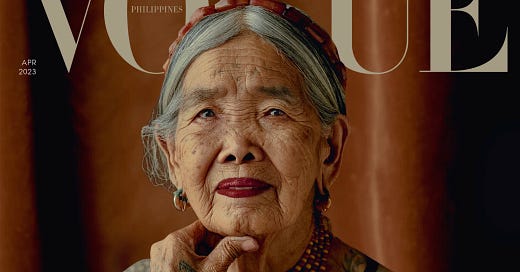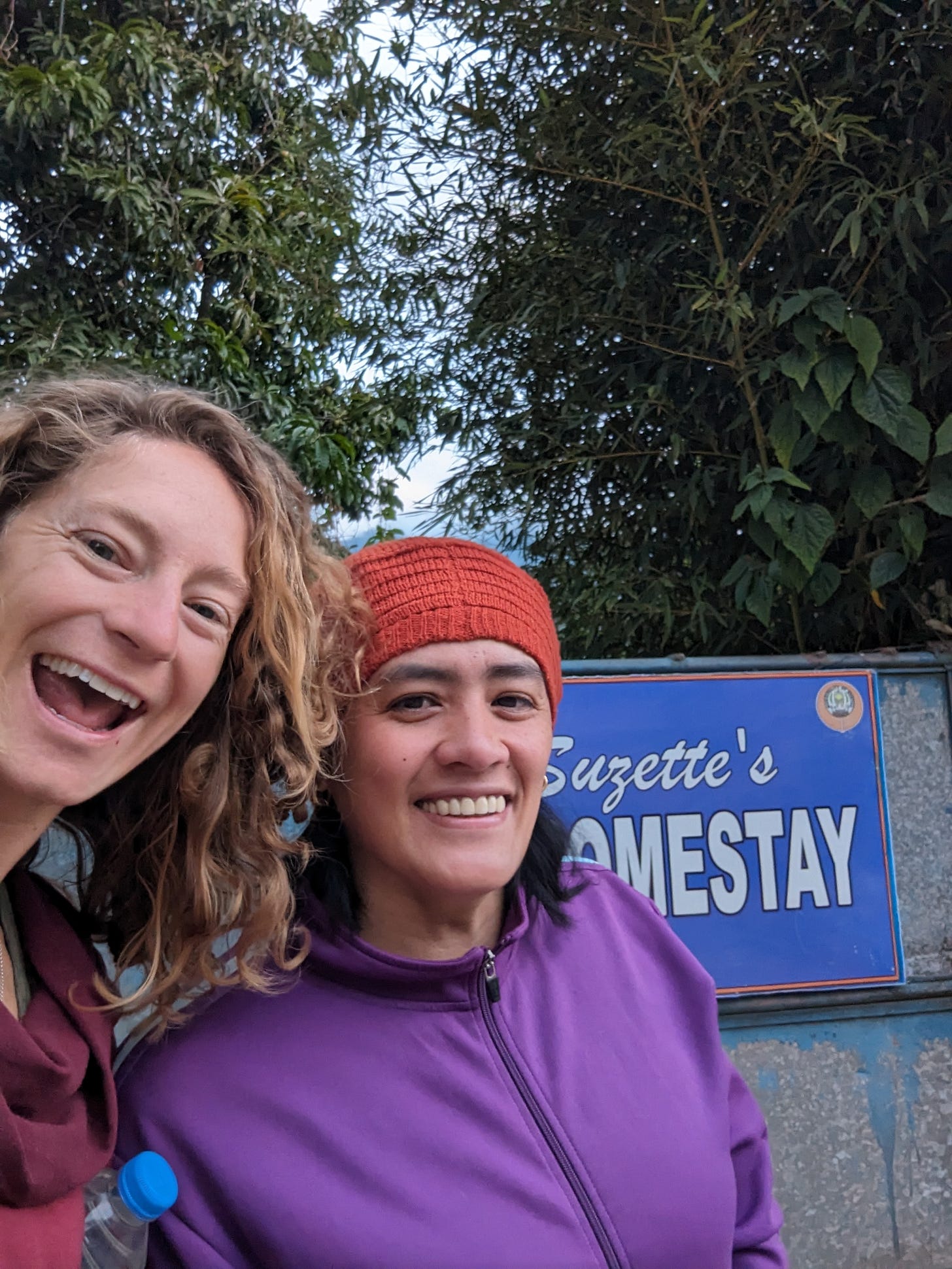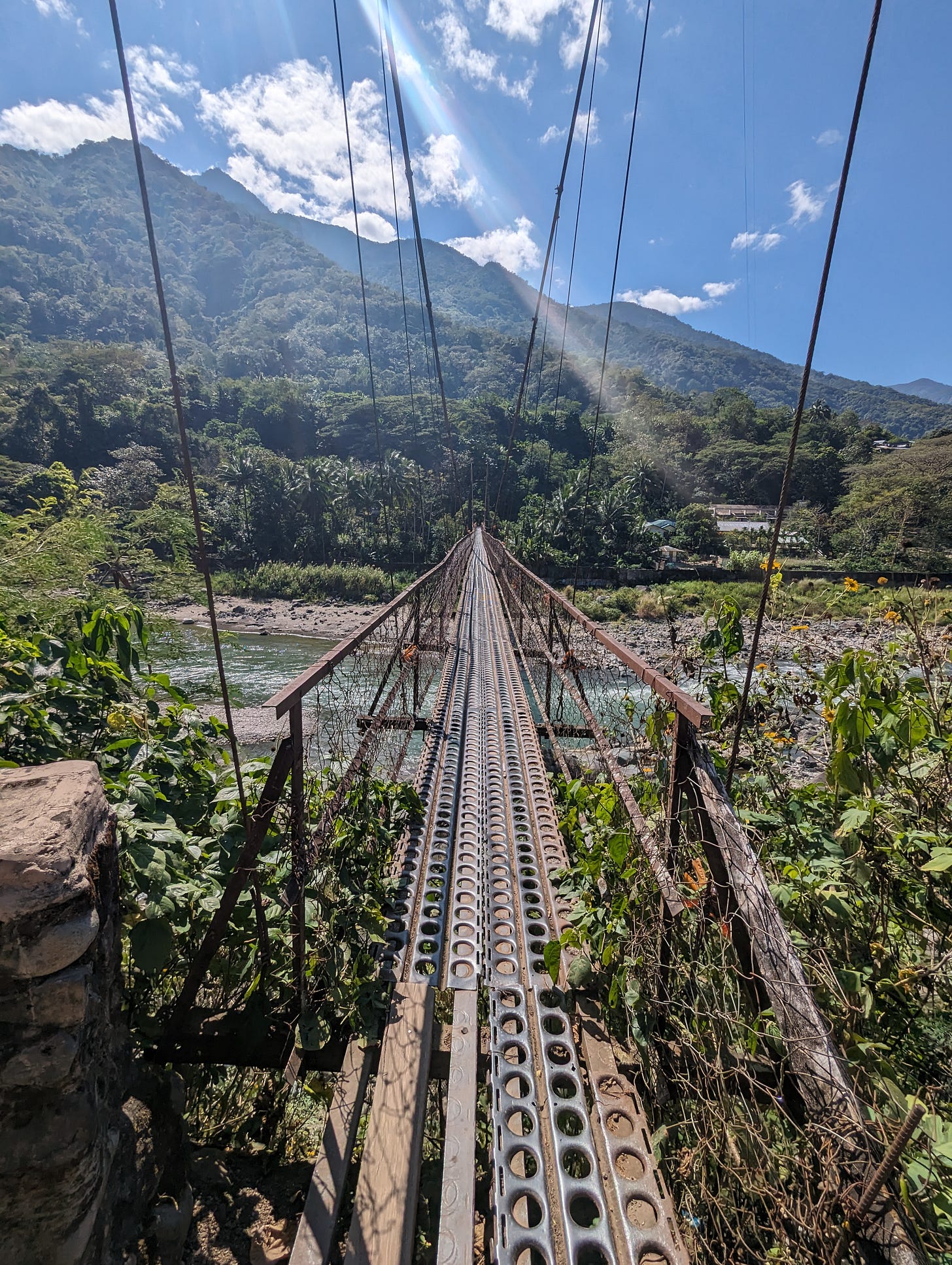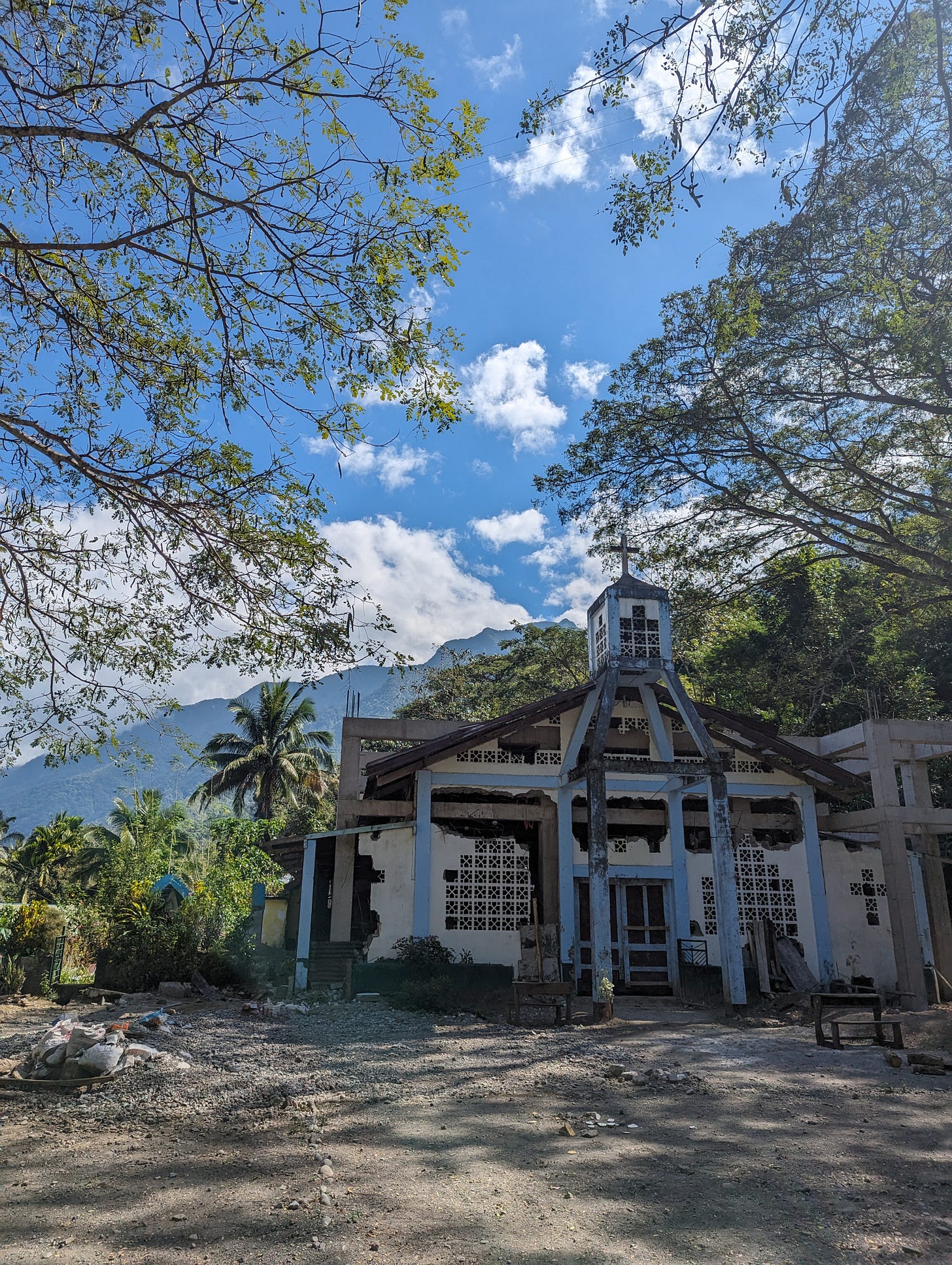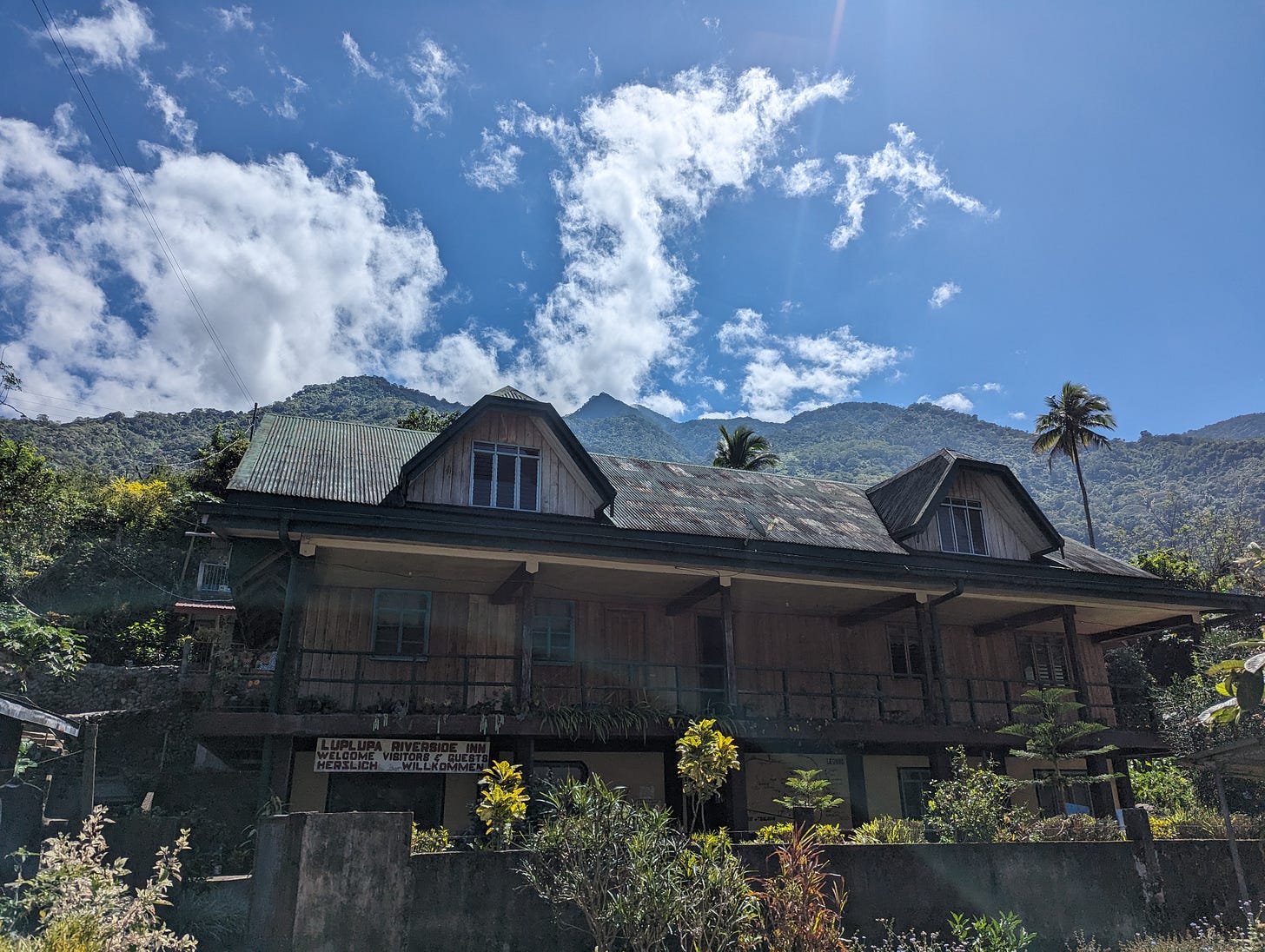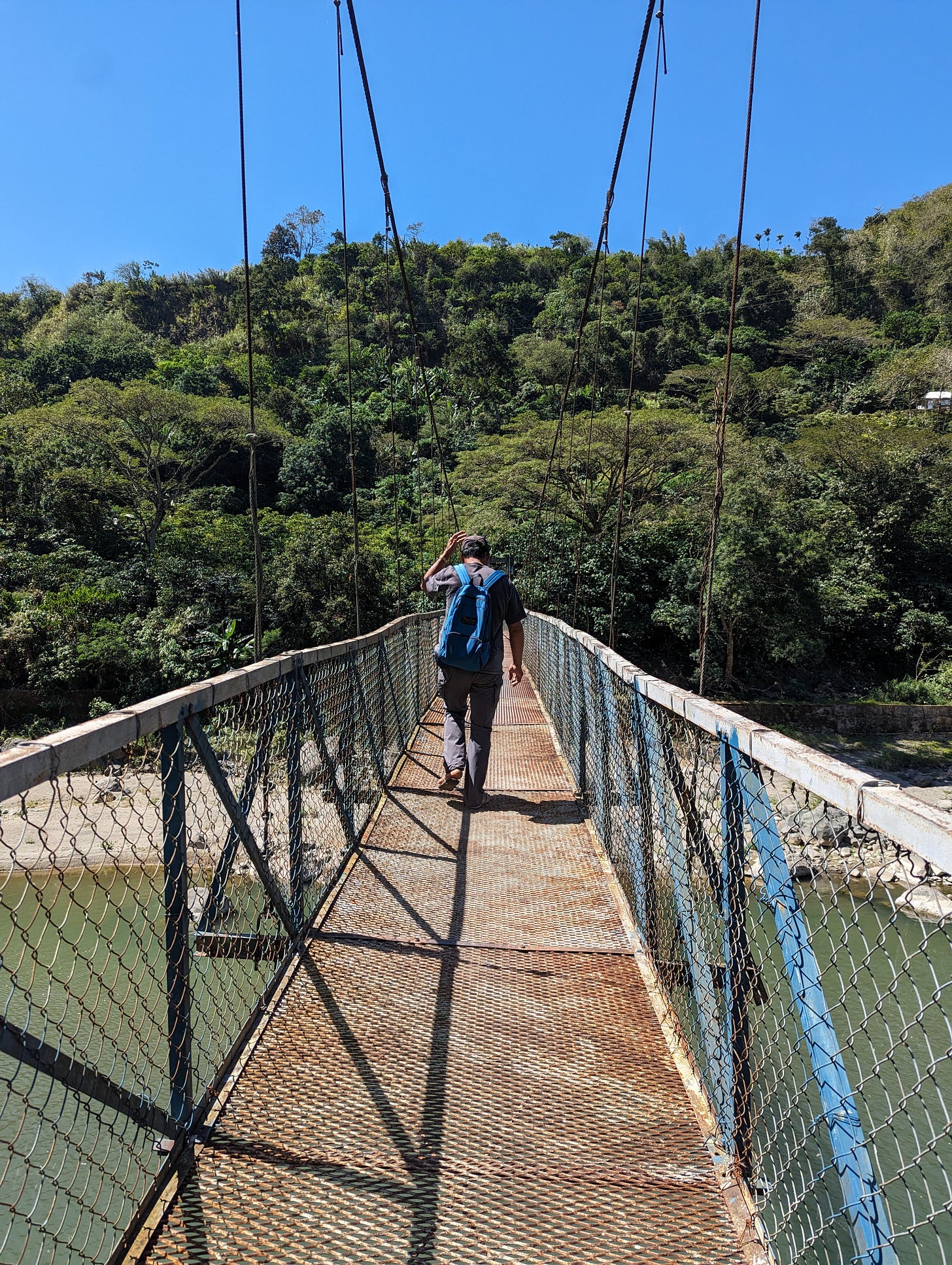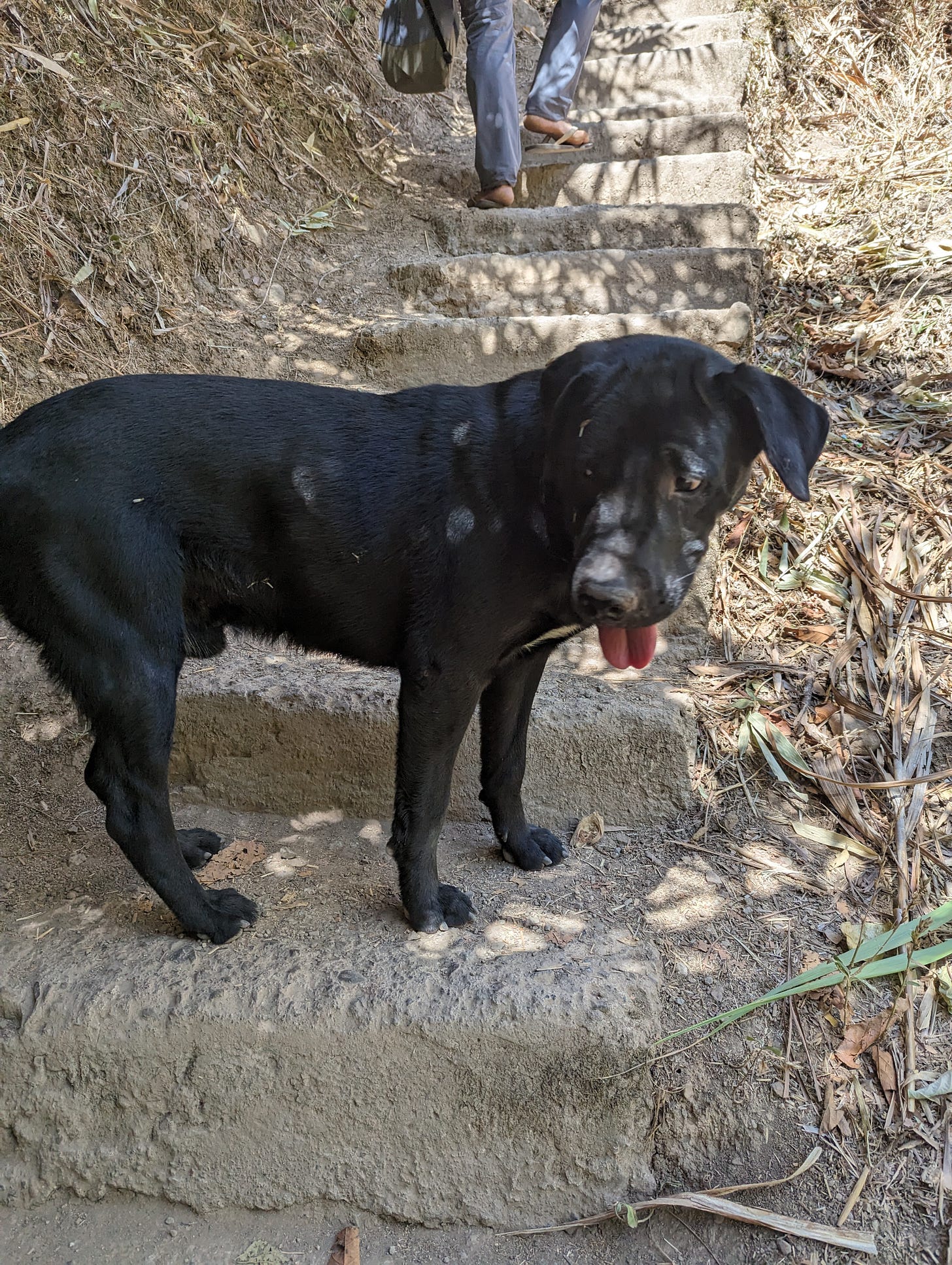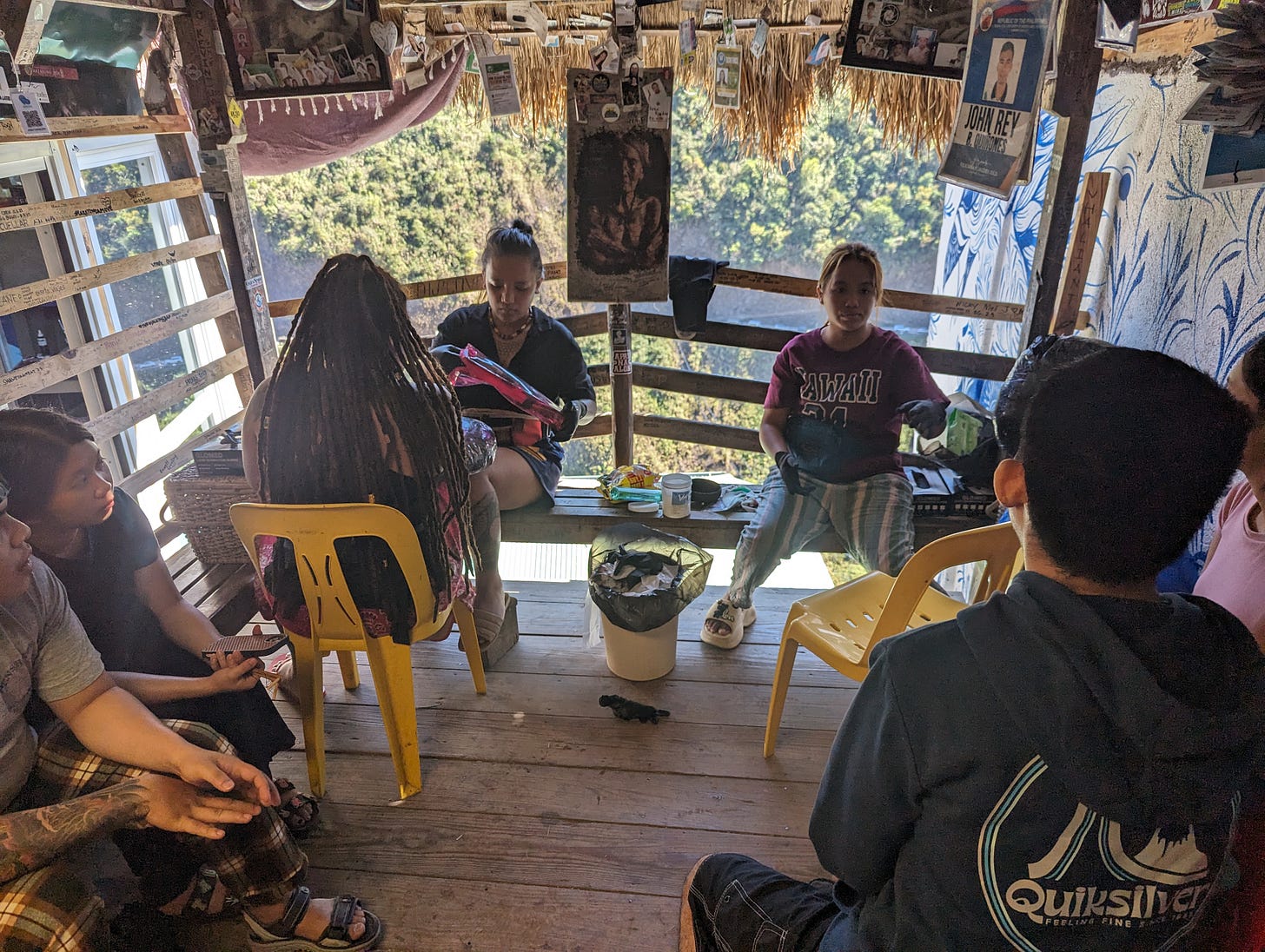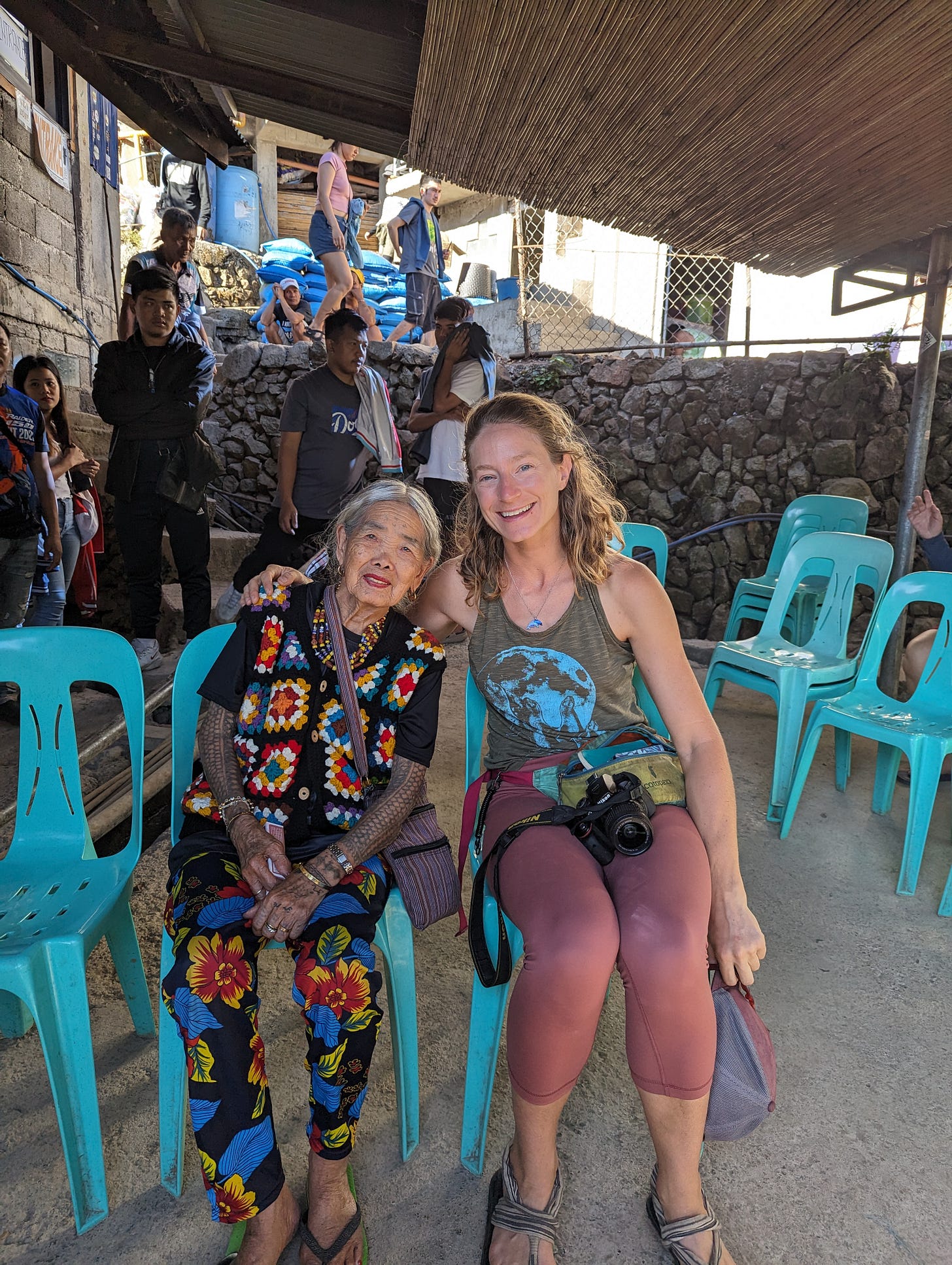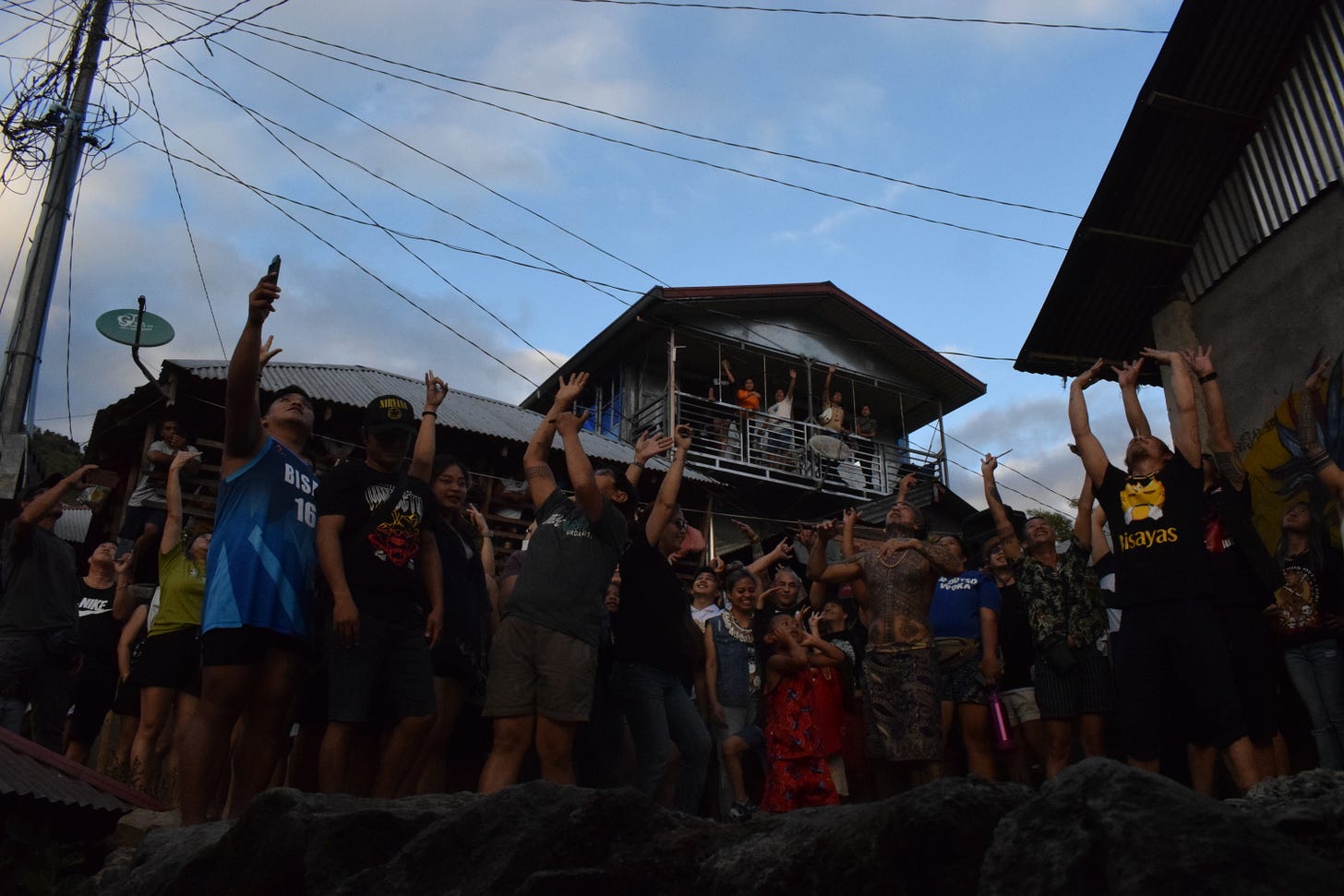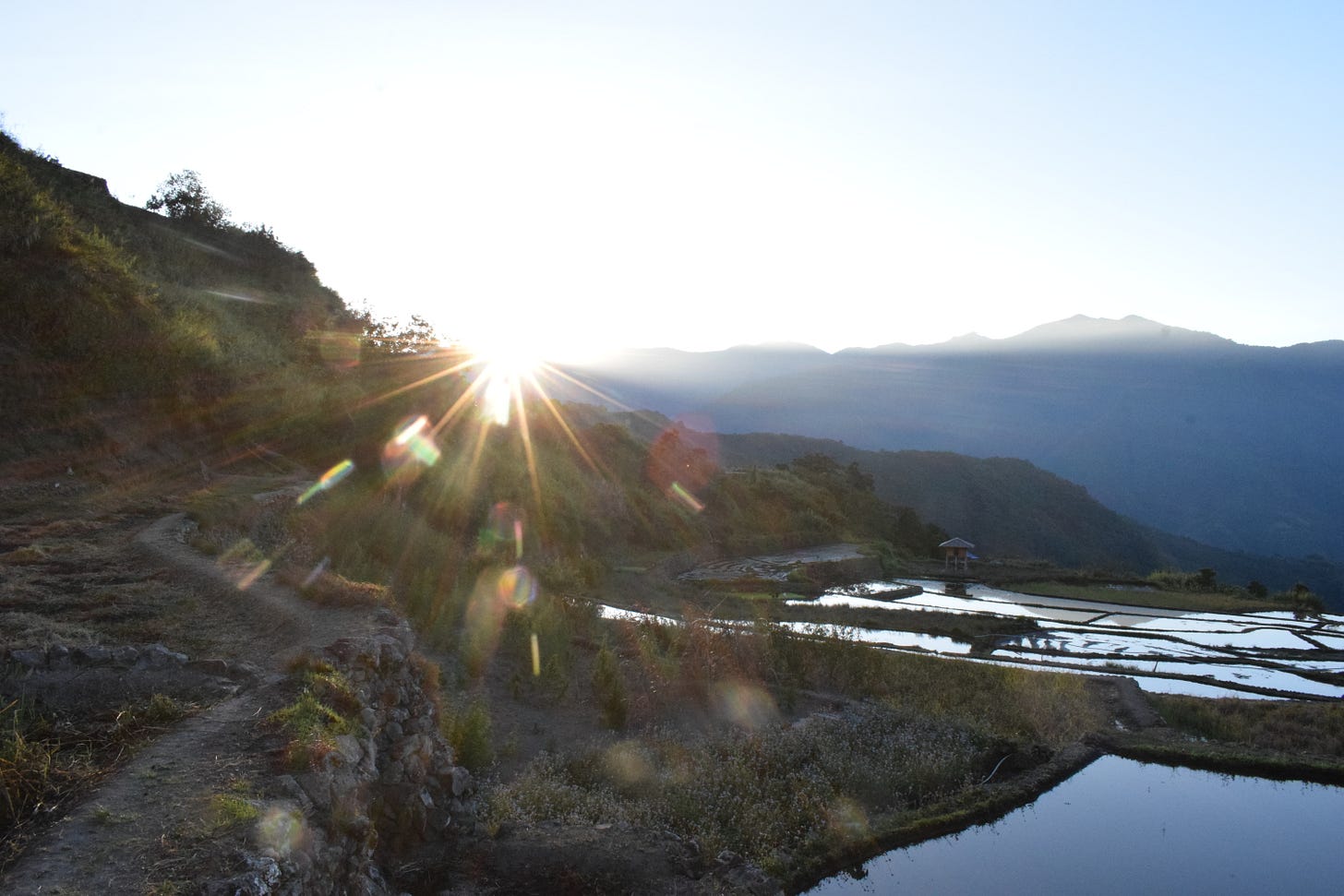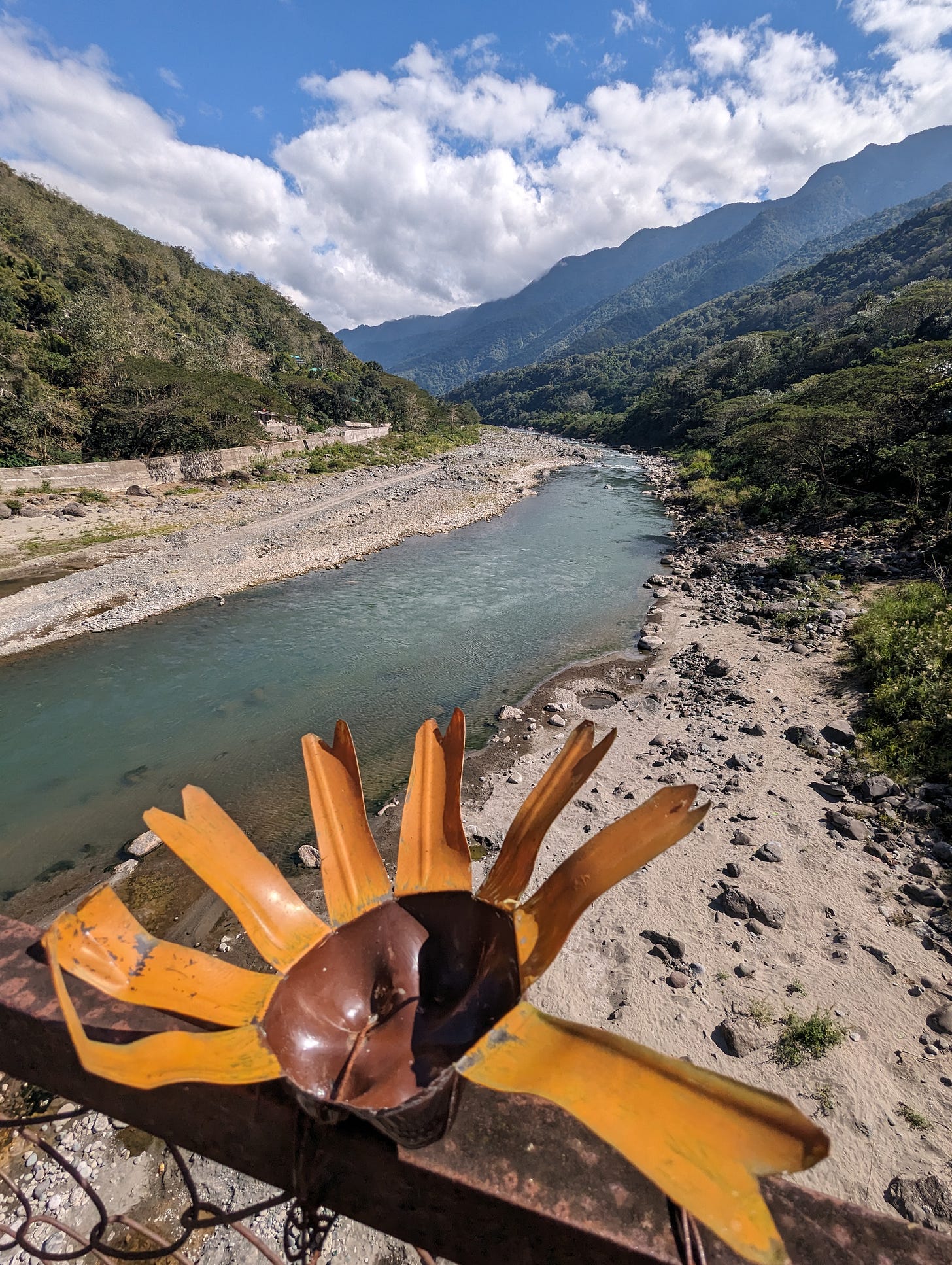Apo means old in Tagalog.
Whang-Od is a celebrity.
And not just because she’s old.
At 107, she’s the oldest woman living in the Philippines, and she also happens to be a trend-setting and talented tattoo artist shifting the narrative around gender roles, beauty and redefining what it means to age gracefully.
This is my story on *spoiler alert* how I ended turning the page on her 106th year with a raging party.
Act 1: Jeeney to Jeepney with luck (and a guide dog) on my side
At 6am on February 17th, I had a nice coffee and pancake made by Suzette, my kind and sweet homestay host at the budding UNESCO site overlooking 2,000 year old rice terraces. We chatted about climbing, she wanted to conquer her fear of heights and try it. The sun was starting to rise over the rice terraces.
With an expert ear, she heard a motor and rushed me ahead. I jumped on the passing Jeepney headed for Bontoc. In Bontoc, I’d take another Jeepney further into the mountains to the town of Luplupa. There, Suzette has arranged for me to meet my guide, who will take me to the town of Buscalan, where Apo Whang-Od lives.
I have a flight that leaves in 2 days, and I am now many Jeepney rides and over 12 hours of bus travel away from Manila. I’m questioning this adventure, is it excessive? Is this all hype? It’s on a tourists top to-dos, especially if they have tattoo.
So when the Jeepney, which had been excessively loud, stopped for an extended time and the driver pulled out a tool box, I started to pour myself into my Plan B, which was to catch the next ride down the mountain and book it back to Baugio.
As we wait, I snacked on some delicious fried yucca and chatted with a woman who was studying law in Bontoc and returning to her family deep in the province of Kalinga for the weekend. She was amused by my travels and amazed that I was doing it alone.
After only 20 or so minutes, they loaded us back on, and we continued up the hill. At the exit to Buscalan, the village, two Filipinos covered in tattoos with overnight bags got off. I had very specific directions from Suzette to go to Luplupa, where I would find my guide, so I stayed on. I knew it was important to go to Luplupa. Not only is it such a creative and fun sounding name, I had bought a book earlier at Padma’s bookstore in Baugio that said, “The River Creatures of Luplupa.” I hadn’t read it, and didn’t know why I bought it except to support Padma (I had literally spent all my pesos that day). I felt there was some magical draw to this place.
We continued on and at this point I felt rather committed. I’m glad I had communicated with my driver earlier because otherwise I would have no idea we were even in a town. I handed him some pesos and walked the wrong way along the mountainous road. The houses started to become more sparse and so I retraced my steps. Eventually a person emerged (I think they had been watching me the whole time) and they pointed down a hidden staircase. At the bottom, two boys were playing with guns and the only next logical step was to cross a rickety suspension bridge perched high above the Rico river.
I do some pretty fear-inducing things on the daily, but this one got me. I could not believe I’d put my trust into this bridge, without any confirmation that it was going to hold. The breeze was fresh and the water turquoise and turbulent below. A group of boys ran from the other side, and while they laughed at me, they calmed my fears. Crossing over was safe enough.
I entered another dimension when I stepped foot in Luplupa. Branches hung over bricks and sunlight streamed in, tickling the gardens of eggplant and sunflowers scattered around each house. I wandered where the footpath took me, peeking in windows, asking for my guide. All I knew was there would be a man named Sir John. A few girls giggled and fled when they saw me. There weren’t that many people to ask. Finally, I walked up some stairs to a school yard guarded by ancient matriarch trees whose roots were the referees to the concrete courts that covered them, bursting out of any rules for constriction. I noticed a church, decrepit with the windows blown out, but the charm of it’s architecture kept its secrets. A little boy playing basketball got up the courage to come over to me and help out his hand. Feeling uncomfortable, I continued on, ducking into another path to find a teenage boy who would finally take me to where Sir John was supposed to be.
We came upon a German-style framed building and I finally met the guy who would be my guide— but it wasn’t Sir John. He was visiting the next town up as his grandmother was in bad health. Or someone had died. Honestly at this point I was quite confused and feeling really out of my comfort zone.
We sat down on the porch with another woman, and they offered me coffee to regroup, though my guide seemed very concerned about the time.
I pulled out my book and showed it to her. She was delighted and said that the woman next door was the one who wrote that book. They illustrated it with the help of the school kids, and it was their origin story. She went on to tell me her story, how the German who owned this hostel also paid for all the children’s tuition and education in the town.
Finally my guide decided we needed to get going, and I put on my backpack and we walked upstream, passing a British woman I had met earlier in a previous town called Sagada. She said she had just been to Buscalan, and she didn’t really like it, too much concrete. They’d been trekking all day and she looked tired.
We continued over another rickety bridge, but this time I felt fortified following my guide. We passed a few rice terraces where a machine rototiller was parked. The field was bright green with the possibility of growth and I felt it too as we ascended up to a bench, where— I learned— we had probably already missed the Jeepney into town (there is only usually one that goes through the mountains a day). The first truck that passed was a friend of my guide’s— but it was full and we let them pass.
The second was a professional colleagues that just completed a land survey. We hopped in and were soon back at the beginning of the trek up to Buscalan. First, we needed to get a little mototaxi to get up there. We found one easy. Then, we needed to hike down and then up to the town.
Act 2: “Conquer Buscalan”
People were sweating as they scaled the steps. I was feeling strong and excited, but also in a rush, still thinking I’d leave that day to get back to Manila (though I knew in the back of my mind that was impossible).
We were guided by a black dog, which waited for us every time we took a water break.
I noticed our guide stopped to chew moma and I asked him about it. Moma is a mix of bettle leaf, tobacco and something else, that alchemizes to a reddish color that people spit out. It has a mildly intoxicating effect.
We finally arrived after paying $200 pesos to gain entrance to the town (to which the gatekeeper scoffed “that’s like $2). Weaving in and out of concrete in a confusing complex, we approached a crowd. In a depression in the concrete, covered in shade clothes, there were almost 75 people waiting to see Apo Whang-Od. It was too much for me, so I motioned for my guide to keep going. We walked to where his friends were eating lunch, and drinking— maybe already drunk.
Discussions of a world war three took place and they started asking me about politics and pressuring me to stay longer and at that moment I knew I could trust my guide, as he noticed my discomfort and we moved along.
The next stop was his niece’s house. She made us coffee and offered us white bread as she bounced her baby in her arms. We discussed how much the town has grown and how many tourists flock here every day to see Apo Whang-Od. During our conversation, her uncle dipped in and out and I realized he was trying to find a place for me to sleep. Many places offer home-stays and it helps support their lives.
We eventually trekked back across the town to where he found a place for me to stay. I’d stay with Apo Whang-Od’s granddaughter Gracie. A curtain would divide me and my guide, and there were two other tourists sleeping in the other room. It was right in front of where the scene was forming.
It felt still too overwhelming and so we continued deeper into the town to visit Gracie as she was tattooing some tourists. I had my camera then and interviewed her and some of the people she was tattooing. I asked her about the process and she described how it felt to be preserving this tradition for her people.
I ventured deeper into the town and saw two more tattoo artists, also women, and even younger. One was 14 and I asked her about schooling. Around them was a group of mountaineers, and I interviewed them too.
There was going to be a pig roast (3 pigs!) and a concert later that day, and after the rush of the day, I decided I needed to nap and regroup. While I overslept and missed the pig roast, I rose to two men painting a colorful cock on the side of one of the concrete houses.
A crowd was growing and soon the whole village was filled with the sounds of rap music, lyrics which alluded to the strength and resilience of this woman. The woman of the day, year and for the last century— Apo Whang-Od. My guide had been tasked with getting a chair for her to sit in while she enjoyed the show. He cleverly brought two and beaconed me to come sit next to her.
I knew this was a big moment, but because of the language barrier, I had nothing prepared to ask her and honestly didn’t really know what to do. I was paralyzed and felt what the phrase “star-shocked” meant.
She motioned to her mouth with all four fingers and her thumb, and I assumed she was reflecting on how tasty the pigs were.
She got up to dance, and I followed suit.
The whole town was bopping up and down in rhythm and in praise of this woman’s life.
I interviewed one of the organizers of the party on his pride of being Filipino. He noted the idea of “Baya Nihan” or helping families out— for example, if one family needs help planting their rice field or building the house, the whole community will show up to help.
Scene 3: The come down and retreat.
As I’m lying in bed that night, I’m wondering about if I need a tattoo to mark this occasion. It’s not the first time I’ve really contemplated getting a tattoo. I once had plans to cover my body in a trail guide to all the creatures that have had an effect on me, like lizards, saguaro cacti, owls, starfish, hummingbirds. I’ve had a moment of feeling called out in Hawai’i as I told my friend his “ohm sign wasn’t straight,” and the tattoo artist later said it was “obvious” I had never had a tattoo. I respect those who do, but I find that my path is one of respecting the purity of my body, not needing to decorate it with ink.
So as I’m raising this question yet again, a man makes his way to the room next to mine and shares that he’s decided, despite peer-pressure, that he does not need to get a tattoo. I felt like that was one massive sign from the universe.
The next morning, I awoke before the sun rose and ventured towards the rice terraces to anticipate the sun rise. I wasn’t the only one with this idea, as tired tourists started trickling in to enjoy the morning. Dancing in the cobbled rows, and in the dirt of the fields, I felt so free. I knew my time was coming to a close, but I was so grateful for this “rudraksha seed” experience to add to my mala necklace of life moments.
I thought of the significance of the number 108, the total number of seeds in a traditional mala. My mind fast-forwarded to next year, what would be Apo Whang-Od’s 108 birthday. What is a year, to someone who has collected over 100? What would this experience mean for some of my friends, if I brought them, following the path I now knew all the way to Buscalan? How can a person, without even communicating using language, have such an impact on so many people?
I thought particularly of my yoga teacher friend, who pencils in 3 dots under her eye, reminding herself of her values. What would it mean to her to have it memorialized by someone with such significance. The three dot tattoo is Apo Whang-Od’s signature. What do tattoos mean for people who decide to create that legacy on their bodies? How does it make them feel to be part of a legacy? What does Apo Whang-Od think when she goes to bed?
With all this questions floating in my head, I found gratitude in the present moment. The same black dog that guided us here was waiting to escort us out. I followed my guide who now felt like a friend back down and out of the chaos of Buscalan.
We retraced our steps, and caught a moto taxi playing John Denver’s “Colorado Rocky Mountain High.” The mountain in the distance was called “Sleeping Beauty.” And I imagined the peace that she brings to the people below in her geographic grace and form.
The final jeepney rolled up, and on it was the British woman coming from Luplupa. It felt surprising to run into her again, and I had a feeling we had something special to exchange with each other. We shared stories of traveling, how to navigate falling in love and moving on while traveling, why it’s easy for us to travel alone but why no one else seems to understand it, and caught each other up on where we’d been around the Philippines and the world. I asked her what she’d return home with, if she’d be changed by the experience.
“I travel like this all the time” was her response and I felt her resistance to the question, as if I was assuming this was separate from her life. While I live life in a way that moves around, there is something distinct about not being in a place that you call home, and have a long legacy with.
She noted the hospitality of the people, and seemed to be changed just by nucleating the question.
In Bontoc, we parted ways, and I boarded my bus set for Baguio. Feeling full circle, I ordered coffee and a pancake. I’d return straight to Manila and wrap up my last day in the Philippines.
What I realized is you act differently when you are near the end of something. There’s a mix of love and wanting to soak in every last significant thing, and also a streamlining to put myself together to jump through the portal. I knew the next adventure was going to be fun, but I was still in a glow about this one. I wondered if Apo Whang-Od has a similar sensation.
With love and longevity,
Holly Cat

